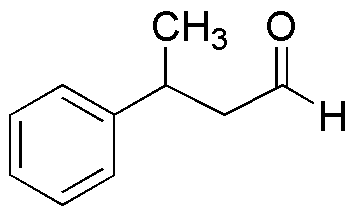3-Phenylbutyraldehyde is widely utilized in research focused on:
- Flavor and Fragrance Industry: This compound is used as a flavoring agent in food products and as a fragrance component in perfumes, providing a sweet, floral aroma that enhances sensory experiences.
- Pharmaceutical Synthesis: It serves as an important intermediate in the synthesis of various pharmaceuticals, enabling the development of new medications with improved efficacy and reduced side effects.
- Organic Synthesis: Researchers utilize it in organic chemistry for the construction of complex molecules, facilitating the development of novel compounds with potential applications in various fields.
- Polymer Production: It can be employed in the production of specialty polymers, contributing to materials with unique properties, such as improved durability and flexibility.
- Research in Chemical Biology: The compound is used in studies exploring biochemical pathways, helping scientists understand metabolic processes and develop targeted therapies for diseases.
General Information
Properties
Safety and Regulations
Applications
3-Phenylbutyraldehyde is widely utilized in research focused on:
- Flavor and Fragrance Industry: This compound is used as a flavoring agent in food products and as a fragrance component in perfumes, providing a sweet, floral aroma that enhances sensory experiences.
- Pharmaceutical Synthesis: It serves as an important intermediate in the synthesis of various pharmaceuticals, enabling the development of new medications with improved efficacy and reduced side effects.
- Organic Synthesis: Researchers utilize it in organic chemistry for the construction of complex molecules, facilitating the development of novel compounds with potential applications in various fields.
- Polymer Production: It can be employed in the production of specialty polymers, contributing to materials with unique properties, such as improved durability and flexibility.
- Research in Chemical Biology: The compound is used in studies exploring biochemical pathways, helping scientists understand metabolic processes and develop targeted therapies for diseases.
Documents
Safety Data Sheets (SDS)
The SDS provides comprehensive safety information on handling, storage, and disposal of the product.
Product Specification (PS)
The PS provides a comprehensive breakdown of the product’s properties, including chemical composition, physical state, purity, and storage requirements. It also details acceptable quality ranges and the product's intended applications.
Certificates of Analysis (COA)
Search for Certificates of Analysis (COA) by entering the products Lot Number. Lot and Batch Numbers can be found on a product’s label following the words ‘Lot’ or ‘Batch’.
Numéro de catalogue
Numéro de lot/série
Certificates Of Origin (COO)
This COO confirms the country where the product was manufactured, and also details the materials and components used in it and whether it is derived from natural, synthetic, or other specific sources. This certificate may be required for customs, trade, and regulatory compliance.
Numéro de catalogue
Numéro de lot/série
Safety Data Sheets (SDS)
The SDS provides comprehensive safety information on handling, storage, and disposal of the product.
DownloadProduct Specification (PS)
The PS provides a comprehensive breakdown of the product’s properties, including chemical composition, physical state, purity, and storage requirements. It also details acceptable quality ranges and the product's intended applications.
DownloadCertificates of Analysis (COA)
Search for Certificates of Analysis (COA) by entering the products Lot Number. Lot and Batch Numbers can be found on a product’s label following the words ‘Lot’ or ‘Batch’.
Numéro de catalogue
Numéro de lot/série
Certificates Of Origin (COO)
This COO confirms the country where the product was manufactured, and also details the materials and components used in it and whether it is derived from natural, synthetic, or other specific sources. This certificate may be required for customs, trade, and regulatory compliance.


